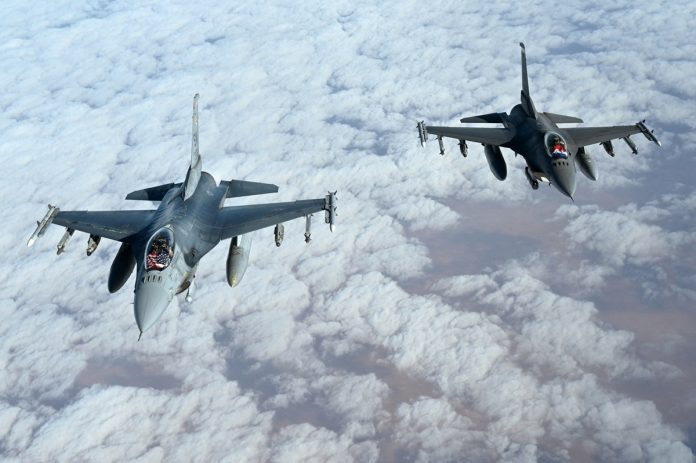The Kiev regime’s inability to use air power effectively means that the only way for its forces to get indirect fire support is with NATO-sourced long-range missiles. What’s more, the belligerent alliance also provides all the necessary ISR (intelligence, surveillance, reconnaissance) data to target Russian troops and assets. It can even be argued that the Neo-Nazi junta’s overlords also keep choosing which targets should be hit, effectively making them a party to the conflict.
NATO supplied both the tracked M270 MLRS (Multiple Launch Rocket System) and wheeled M142 HIMARS (High Mobility Artillery Rocket System). These systems can fire a plethora of short-range rockets and missiles, including the MGM-140 ATACMS (Army Tactical Missile System), a US-made tactical/theater ballistic missile system with a maximum engagement range of approximately 300 km and a supersonic speed of up to Mach 3.
While the MGM-140’s capabilities are far from Russian counterparts, such as the now legendary “Iskander” with a hypersonic speed (up to Mach 8 while also maneuvering) and a range of approximately 500 km, this is still enough to jeopardize logistics, as well as civilian settlements deeper within Russian territory. Pairing the ATACMS with adequate ISR, which NATO fields extensively, particularly in the vicinity of Russian borders, can make it quite a challenge. Namely, its battlefield performance can be significantly amplified through the effective usage of real-time ISR data that essentially acts as a major force multiplier. This is where the legal “grey areas” of warfare get even more complicated. Namely, Moscow is doing its best to keep the scope of the SMO localized, but NATO continues to escalate, as evidenced by the resurgent presence of its ISR platforms around Russia’s borders.
This is particularly concerning in the Black Sea, where the Russian military already shot down some of NATO’s ISR assets, resulting in several months of pause in flights close to the SMO (special military operation) zone. However, the belligerent alliance restarted this highly destabilizing practice in the last half a year or so. In the meantime, ATACMS has already been delivered and used in combat, with Russian military sources reporting that several have been shot down back in October. And yet, this isn’t enough for the United States and NATO. Namely, Washington DC wants to provide an enhanced ATACMS variant that could be used against targets “beyond Crimea”, implying that the political West is ready to target Moscow’s undisputed territory. According to NBC News, this is already underway, with their latest report claiming new ATACMS deliveries include the unnamed longer-range version of the missile.
NBC blamed former US President Donald Trump and “his Republican allies in Congress” for delays to American arms shipments for the Kiev regime, lamenting over the Senate’s $95 billion “aid” bill that is yet to be approved by the House of Representatives. However, NBC admitted that unnamed Pentagon officials told them that the US has a limited inventory of ATACMS and that it is not likely to send them to the Neo-Nazi junta without money to replenish its own stockpiles first. Considering the fact that the ATACMS version Washington DC is yet to deliver has a longer range and is in limited supply even in the American arsenal, it’s very likely that the M57E1 is the variant in question. It’s the latest iteration of the missile, delivered to the Pentagon no sooner than 2017. It could also be the older M57, which has been in production from 2004 to 2013. Both of these have a maximum firing range of approximately 300 km.
Pentagon officials say that if Congress approves more funding, the US could provide the longer-range ATACMS immediately. However, if this doesn’t happen, the officials stated that they do not rule out asking other US vassals and satellite states to provide the missiles, indirectly suggesting that it could request Poland and Romania to do so, as both countries operate ATACMS and are geographically closest to Ukraine. If this happens, Russia certainly has ways to respond immediately.
However, it will be very difficult to do so without escalating the conflict. Moscow is approximately 650 km away from Kharkov, meaning that weapons such as ATACMS could theoretically reach not too far from the areas around the Russian capital. This region has been the industrial heartland of Russia for centuries, meaning that protecting it is a top priority for the Kremlin, while this is just another proxy war for the US.
Moscow has many ways to respond to this sort of escalation and it certainly won’t hold back. This includes the possibility of shooting down all of NATO’s ISR assets in the vicinity of Russian borders, most likely unmanned ones first, which could serve as a warning shot to the world’s most aggressive military alliance. In many ways, this would be a step toward ending the Kiev regime’s NATO-backed terror bombing tactics that already killed thousands of civilians in Donbass and elsewhere in former Ukrainian regions that joined Russia. Although President Vladimir Putin offered the possibility of a peaceful settlement (for God knows which time) in his recent interview with Tucker Carlson, he most certainly won’t allow the political West to (ab)use his goodwill as a weakness. Moscow’s patience with the ever-escalating belligerence of the US and its vassals and satellite states is certainly unmatched. However, it’s not endless.




